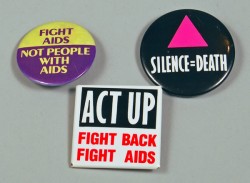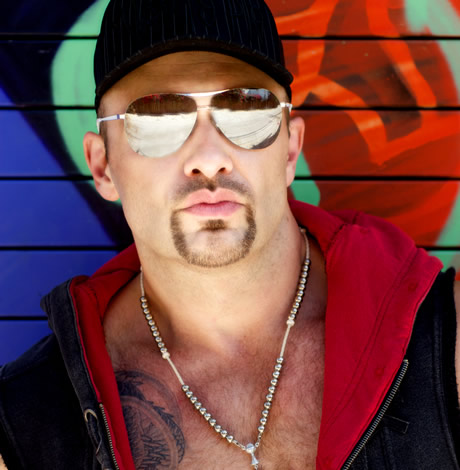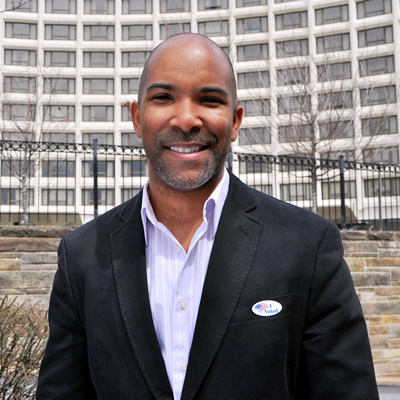Miscellaneous
Community in crisis
New Smithsonian AIDS exhibit gathers ‘80s-era artifacts
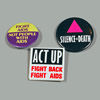
On June 5, 1981, five unusual cases of pneumonia in patients in Los Angeles were reported in the “Morbidity and Mortality Weekly,” a newsletter from the Centers for Disease Control and Prevention.
It was the first notice taken by federal public health officials of a deadly virus — later dubbed HIV, for human immunodeficiency virus — that already claimed countless lives, but without a diagnosis pinpointing why. The plague had begun. It just didn’t have a name yet.
Now, 30 years later, the National Museum of American History, one of the Smithsonian museums on the Mall, the same museum featuring serious history and also pop culture, is marking this anniversary of what became known as the HIV and AIDS epidemic with a three-party display and website beginning June 3.
“With this first official notice of the illness, thousands were infected before anyone knew,” says the exhibit’s curator, Katherine Ott, who has been working with an American History Museum team to plan it for the past year and a half. “The full pattern simply didn’t emerge until later.”
The public health and scientific as well as political responses to HIV/AIDS during the earliest phase, from 1981 to 1987, with original magazine covers and copies of reports plus lab equipment used to isolate the virus, are the focus of one of the three parts, the showcase to be in the museum’s Science in American Life exhibition area.
Another set of materials, dating from 1985 through 2009 — including movie posters, such as for the 1993 film “Philadelphia” starring Tom Hanks and Denzel Washington — will show in the museum’s Archives Center how individuals and society were affected by the epidemic.
Finally, on the first-floor Artifacts Wall, the museum will display a panel from the AIDS Memorial Quilt of the Names Project Foundation, honoring Roger Lyon, who died of complications from AIDS in 1984. A year earlier, Lyons testified before a Congressional hearing, throwing down a challenge to his listeners: “I came here today to ask that this nation with all its resources and compassion not let my epitaph read that he died of red tape.”
But red tape and even worse, reluctance to face facts, often rooted in homophobia, led to denial that anything serious was happening and a crucial delay in addressing the epidemic. For years it was ignored by many in the political establishment, such as President Ronald Reagan, whose first speech on the subject only came in 1987.
Looking back at the early period, as the illness emerged and little was done to combat it, Ott, a lesbian, says “I have friends who died, mostly in the 1980s, as a result.”
“There’s a visceral aspect to this that other anniversaries just don’t have, for people who lived through this, including those who became sero-positive in the 1980s and are still alive,” says Ott, who also has “friends and colleagues who are living with AIDS now.”
“Anniversaries like this one are a perfect time to reflect, to see where we are today, and how much things have changed, because it’s almost two generations now since the first HIV reports. But in HIV years it’s probably more like seven generations. So much has changed.”
A month after the first CDC newsletter notice came a short article in the New York Times, headlined “Rare cancer seen in 41 homosexuals,” and as the year 1981 ended, 121 deaths were recorded with the cause labeled “gay-related immune deficiency” or GRID.
The Grim Reaper indeed stalked gay men but as the scourge was fully understood, one caused by a virus passed through blood or bodily fluid transmission, its dimensions were finally understood as constituting a global pandemic afflicting both genders, and worst of all in sub-Saharan Africa. In 2009, an estimated 33 million people worldwide were living with HIV-AIDS, with 2.1 million fatalities from the illness that year and also with 2.6 million new infections every year.
Today an estimated 600,000 men, women and children in the U.S. have lost their lives to the many complications from AIDS. Although numbers of those infected had been dropping in the U.S. earlier, that has begun to change in recent years. In 2009, District of Columbia HIV-AIDS officials reported that at least 3 percent of D.C. residents have HIV or AIDS. D.C. is now often called the nation’s HIV-AIDS capital.
Ott, whose Ph.D. is in the history of science and medicine from Temple University, has been a curator at the museum for 15 years. She acknowledges that the exhibit has been extensively vetted within the museum, due to the controversy last year at a sister Smithsonian museum, the National Portrait Gallery, over the “Hide/Seek” exhibit there. She said Brent Glass, the History Museum director, “because of sensitivity over that,” had asked for a review of the HIV-AIDS exhibit by “the Castle,” a reference to the Smithsonian headquarters. Glass now says that, “this display will help visitors understand why these events gripped America 30 years ago.”
Ott says she hopes there’s an audience for the new exhibit, especially for younger people whom she says “have no idea really what we went through, and who now know that HIV infection is not an automatic death sentence, the way it was 25 or 30 years ago.”
She says she has interns today who have never even heard of Rock Hudson, the actor whose death from AIDS-related illness in 1985 made him one of the first celebrities to die from the virus. She sees the exhibit as “a chance for younger people to learn about how there were still sodomy laws in half of the states and how homophobia and the fear of this disease was so intense in the 1980s.”
Of course the virus is not specific to gay male sex, but because it was first detected there, and spread so rapidly through the gay male community, it became linked in the public’s mind to gay males as well as two other marginalized or outsider groups, Haitians and intravenous-drug users. The stigma was deeply set and led to laws being passed that discriminated against people with AIDS in insurance and housing and the workplace.
These sanctions were linked to homophobia and often took the form of enforcing traditional attitudes about sexuality, as cities like San Francisco and New York took steps by 1984 to close down bathhouses and sex clubs. But gay males and their allies, often lesbians, began to act when others would not, to care for those stricken with the illness as well as to push back against vicious anti-gay ignorance with public education campaigns to promote what came to be known as “safe sex.”
The museum exhibit showcases this entire period, with a focus on several of the stages — first, as a public health crisis, when the word was being passed about how AIDS was transmitted and how to prevent the disease’s spread; and then as a scientific mystery, when a high-stakes international race began, to find the cause of the illness; and also as a political flashpoint, when some voices were raised condemning homosexuality as a sin and sometimes even that AIDS was a suitable punishment for such infractions. Other voices challenged Reagan administration inaction, especially in 1987 when activists took to the streets in civil disobedience through ACT UP — the “AIDS Coalition To Unleash Power,” with its familiar pink triangle and its emblematic slogan of “Silence = Death.”
Depicting these stages are magazine covers such as one from The Advocate in 1981, with its front-page headline question, “Is The Urban Gay Male Lifestyle Hazardous to your Health?” about the “new diseases attacking gay men.
Another cover story — headlined “Epidemic,” about the “mysterious and deadly disease called AIDS” — appeared in Newsweek in April 1983. Ott says that its lead author decided to focus on the illness partly as a result of the fact that he had a brother who was gay and who later died from AIDS complications.
Other items on display are the early reports and pamphlets charting the course of efforts to combat the disease. The museum has collected what Ott calls “a lot of the paper ephemera, much of which was educational, to get the word out, including efforts to promote safe-sex practices, such as a booklet titled “How To Have Sex in An Epidemic,” co-authored by Richard Berkowitz and Michael Callen, advocating the use of condoms and other measures for safe sex; and a pamphlet from 1982 titled “Healthy Sex is Great Sex.”
Also shown is an early safe-sex teaching manual, “Teaching AIDS: A Resource Guide on AIDS,” co-authored by a social worker Marcia Quackenbush, whom Ott says “began working in sex education with gay youth in San Francisco and she’s still active.”
Quackenbush in fact will be among the bloggers at the exhibit’s website, which will log in new comments from experts about the exhibit once or twice a month. The exhibit is expected to run until November, though no definite closing has been set yet; it will depend on when the museum’s West Wing, where the materials on display will be housed, must be closed for renovations.
Some of the displayed material comes from the extensive collection of research materials donated in 2008 to the museum by the writer John-Manuel Andriote, author of the 1999 book “Victory Deferred: How AIDS Changed Gay Life in America.” Andriote, who lived in Washington for several decades until returning home to Connecticut in 2007, completed in 2010 a series of interviews to update the book, which will be re-issued later this year in a new edition.
Andriote, who learned he was HIV-positive in 2005, says that in his interviews last year he was, “Startled to hear gay men now say that their sense of the crisis has passed, that HIV has become ‘normal,’ a harsh fact of life but not what defines or necessarily ends it.”
The exhibit also displays antibody tests from 1985 and condoms distributed to gay men in the early and mid-1980s, with a stress on the importance of their use to combat AIDS. One section shows how those test kits emerged from the research in 1983-1984 of two physicians, Luc Montagnier (Pasteur Institute, Paris) and Robert Gallo (National Institute of Health, Bethesda), whose pioneering lab work led to them being recognized as the co-discoverers of HIV as the virus responsible for the cause of AIDS. They co-patented the test kit and split its royalties.
A fascinating feature of the exhibit is the timeline for the years 1981 to 1987, which shows key dates defining the early panic over the illness — such as in 1985, the same year Rock Hudson died and also when the first antibody tests began to be used, when the student Ryan White, a teenaged hemophiliac who contracted HIV from a contaminated blood treatment, was expelled from his Kokomo, Ind., middle school, though doctors insisted he posed no risk to other students.
The next year, as the exhibit shows, came the first drug treatment — AZT, a type of antiretroviral drug, originally marketed under the name Retrovir — that helps to slow the spread of HIV in the body but does not stop it entirely. Also in 1986 came the first official U.S. government policy document on HIV/AIDS, which advocated the use of condoms, infuriating the right wing. It was the landmark study by C. Everett Koop, the U.S. Surgeon General, of which a copy is on display in the exhibit.
But progress in understanding the disease came only in fits and starts, as the exhibit reveals, and key information sometimes lagged for years. Ott notes that for a long period “women with AIDS, who were predominantly poor and African American or Latina, were excluded from clinical tests, and that the official AIDS definition did not include diseases specific to women until 1994.”
The exhibit and its companion website are open to the public beginning today.
Miscellaneous
What it means to be an active ally to your LGBTQ+ co-workers TEST
Five easy tips to help you avoid common risks
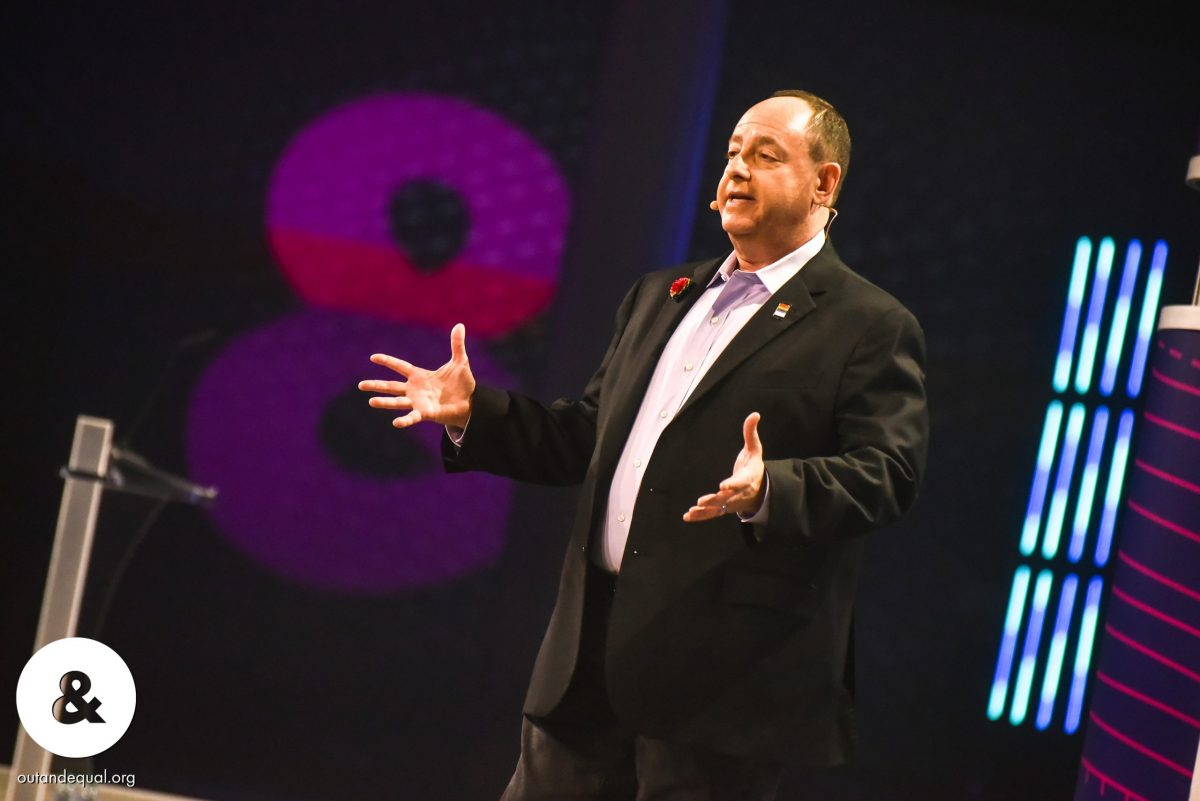
Your home is more than just a place to eat and sleep; it’s your safe haven. As much as you might cherish your home, you should probably also recognize the potential hazards within its familiar walls. Accidents can happen in an instant, yet with a little foresight and some simple adjustments, you can transform your house into a safer haven.
Accidents can happen anywhere, and with a few simple tweaks, you can lower risks in your space. Below you’ll find five tips for each room in your home to help prevent injuries, falls, and other mishaps. In short, home safety.
This article was inspired by a shower in a rental we managed that began leaking through the kitchen ceiling below. If only the landlord had installed grab bars, right!? Below, we’ll guide you through the steps to fortify your bathroom, making it a place of relaxation without the fear of slips and falls. Then, we’ll venture into the room where the magic happens, where proper planning can ensure great nights and peaceful mornings. We’ll show you how to prevent accidents while you experiment becoming the next Gordon Ramsey. And we’ll include a few surprising solutions for those other rooms that hold their own unique hazards, offering solutions to safeguard against unexpected mishaps.
Bathroom Safety
Install Grab Bars: Adding grab bars near the shower and toilet can provide essential support for family members of all ages. Not only can they help with getting in and out, but they can help provide stability when washing. Make sure they are securely anchored to the wall.
Non-Slip Mats: Place non-slip mats inside the shower and bathtub to prevent slips. They’re a small investment that can save you from falls and head injuries.
Adjust Water Temperature: Ensure your hot water is set to a safe temperature to avoid scalding. The hot water heater should be set to around 120°F (49°C)l, the middle setting on many water heater settings.
Medicine Cabinet Locks: If you have young children, use childproof locks on your medicine cabinet to keep harmful substances out of reach.
Proper Lighting: Ensure there’s adequate lighting in the bathroom to avoid trips and falls during nighttime visits. Nightlights can be a simple and effective solution.
Bedroom Safety
Clear Pathways: Keep pathways in the bedroom clutter free to prevent tripping. Ensure there’s enough space to move around comfortably, particularly getting around the bed. Be aware where all furniture is when walking around to avoid stubbed toes, particularly at night.
Secure Rugs: If you have throw rugs, use rug grippers or double-sided tape to keep them from slipping. Loose rugs are a common trip hazard.
Bed Rails: For anyone at risk of falling out of bed, consider installing bed rails to provide extra support and prevent falls.
Nightstands with Drawers: Opt for nightstands with drawers to keep essential items. This reduces the need to get out of bed at night, minimizing the risk of falls, as you race to grab what you need and not lose a moment’s rest.
Fire Safety: Install battery-operated smoke detectors in the bedrooms if there are none. Make sure to install them 36 inches away from an air vent or the edge of a ceiling fan. Also six inches away from the joint between the wall and ceiling. And test smoke detectors regularly.
Kitchen Safety
Non-Slip Flooring: Choose slip-resistant rugs in the kitchen, especially in areas where spills are common. Mats near the sink and stove can also help and you can often buy them fairly cheaply at Costco.
Childproof Cabinets: If you have little ones, use childproof latches on cabinets and drawers to prevent them from accessing potentially hazardous items.
Anti-tip brackets: Install an anti-tip bracket behind the range. These are often used when children are in the home. Although they are less likely to open the oven door and use it as a step stool to get to the stove-top, adults can also benefit from installing these.
Adequate Lighting: Proper lighting is crucial in the kitchen to avoid accidents. Under-cabinet lighting can illuminate work areas effectively.
Secure Heavy Items: Ensure heavy pots and pans are stored at waist level to prevent straining or dropping them from high shelves.
Sharp Object Storage: Keep knives and other sharp objects in a secure drawer or block. And handle all sharp items with extreme care, even when washing and drying. These steps reduce the risk of accidental cuts.
Other Safety Tips
Furniture Anchors: Secure heavy furniture, like bookshelves and dressers, to the wall to prevent tip-overs, especially if you have young children.
Adequate Outlets: Check for damaged outlets and replace them promptly. Avoid overloading circuits with too many devices. Install placeholder plugs in outlets to prevent young curious fingers (or tongues?) from going inside an electrical outlet.
Stair Gates: If your home has stairs, install safety gates at the top and bottom to prevent falls, especially if you have toddlers or pets to keep them off of the stairs when you cannot monitor them.
Emergency Escape Plan: Develop and practice an emergency escape plan with your family, including a designated meeting place outside.
Carbon Monoxide Detector: If your home burns any fossil fuels for heating or appliances, install carbon monoxide detectors in common areas of your home to detect this odorless gas. The D.C. building codes require this if you use a fireplace or if you have an attached garage. In essence, if there is any potential source of carbon monoxide in the home, be sure to install these detectors.
Remember, a safer home not only prevents accidents but also provides peace of mind for you and your family. Implement these simple tips to create a secure environment in every room of your house.
With these practical tips and a few adjustments, you can significantly reduce the risk of injuries and falls in your home. Enjoy peace of mind in your now much safer haven.
Scott Bloom is owner and senior property manager of Columbia Property Management.

When Lizzo sings “If I’m shinin,’ everybody gonna shine,” in her hit song, “Juice,” she means it. Proof of that came this week on Instagram when the LGBTQ ally announced the first winner of her annual Juneteenth Giveback Campaign is the Marsha P. Johnson Institute, a national nonprofit based in Richmond, Calif., dedicated to the protection and defense of Black transgender people.
And she did so in song: “On the first day of Juneteenth, Lizzo gave to me,” she sang in her video, posted Tuesday, as she revealed her $50,000 gift to MPJI.
“That’s right, we know who Marsha P. Johnson is. We know what Marsha P. Johnson has done for the LGBTQ, emphasis on that ‘T,’ Q community,” said Lizzo to her 13.5 million followers. “Thank you so much to the people at the Marsha P. Johnson Institute. You deserve this, and I hope this helps you so much as you help protect our Black trans family.”
“What the Marsha P. Johnson Institute does is protects and defends the rights of Black transgender people. They do this by organizing community, advocating for the people, and creating an intentional healing community, developing transformative leadership and promoting collective power,” she said.
“We are overjoyed for the shoutout from Lizzo today, the generosity of her sharing her platform and the recognition of MPJI and its work,” said Elle Moxley, MPJI’s executive director. “The resources from this campaign will ensure the protection and defense of Black transgender people continue at a time where it is so vitally needed. We are so grateful for the support of Lizzo and her fans.”
As one of Time Magazine’s Persons of the Year for 2019 and a 2023 Grammy winner, Lizzo is more than a pop star but an inspiration to millions of fans for her body-positive attitude, her self-confidence on stage and in her videos, her empowering music and her activism. She’s also the founder of her own clothing line, Yitty. In 2021, she made headlines when she publicly corrected a paparazzo for using “she/her” pronouns and misgendering Demi Levato.
As part of her campaign, now in its 4th year, Lizzo recognizes Black-led grassroots organizations and businesses and encourages her fans to join her in supporting each of the five organizations she highlights this week. Fans who take action by donating are entered into a drawing for an all-expenses paid trip to see her perform at Fuji Rock in Japan later this year.
This week’s other nonprofits receiving gifts are: Black Girls Smile, Sphinx Music, the University of Houston and Save Our Sisters United.
Find out more about Lizzo’s 4th annual Juneteenth Giveback Campaign by clicking here.
Celebrity News
Anne Heche dies after removal from life support
Actress dated Ellen DeGeneres in late 1990s

Actress Anne Heche died after she was removed from life support on Sunday, nearly two weeks after her Mini-Cooper crashed through a two-story house in Los Angeles’ Mar Vista neighborhood. Investigators with the Los Angeles Police Department believe she was intoxicated at the time.
She sustained a severe anoxic brain injury along with severe burns and was being treated at the Grossman Burn Center at West Hills Hospital, near Chatsworth in the San Fernando Valley.
The 53-year-old actress who was a star of films like “Donnie Brasco,” the political satire “Wag the Dog” and the 1998 remake of “Psycho,” had been declared legally dead under California law on Friday, however, her family kept her alive long enough to be an organ donor.
In a statement Friday, the LAPD announced that: “As of today, there will be no further investigative efforts made in this case. Any information or records that have been requested prior to this turn of events will still be collected as they arrive as a matter of formalities and included in the overall case. When a person suspected of a crime expires, we do not present for filing consideration.” LAPD detectives had previously made public that investigators into the crash found narcotics in a blood sample taken from Heche.
The actress’s family released a statement on Friday:
“Today we lost a bright light, a kind and most joyful soul, a loving mother, and a loyal friend. Anne will be deeply missed but she lives on through her beautiful sons, her iconic body of work, and her passionate advocacy. Her bravery for always standing in her truth, spreading her message of love and acceptance, will continue to have a lasting impact,” the statement added.
Heche was married to camera operator Coleman Laffoon from 2001 to 2009. The two had a son, Homer, together. She had another son, named Atlas, during a relationship with actor James Tupper, her co-star on the TV series “Men In Trees.”
Laffoon left a moving tribute on an Instagram reel in which he also gave an update on how their 20-year-old son Homer Laffoon is coping with the loss of his mother.
“I loved her and I miss her, and I’m always going to,” he said adding: “Homer is okay. He’s grieving, of course, and it’s rough. It’s really rough, as probably anybody can imagine. But he’s surrounded by family and he’s strong, and he’s gonna be okay.”
“Rest In Peace, Mom, I love you, Homer,” the actor’s 20-year-old son, Homer, said in a statement after Heche was declared legally dead on Friday.“ My brother Atlas and I lost our Mom,” read the statement. “After six days of almost unbelievable emotional swings, I am left with a deep, wordless sadness. Hopefully, my mom is free from pain and beginning to explore what I like to imagine as her eternal freedom. Over those six days, thousands of friends, family, and fans made their hearts known to me. I am grateful for their love, as I am for the support of my Dad, Coley, and my stepmom Alexi who continue to be my rock during this time. Rest In Peace Mom, I love you, Homer.”
Tupper, a Canadian actor who starred alongside Heche in “Men in Trees,” had a 13-year-old son, Atlas, with her. “Love you forever,” Tupper, 57, wrote on his Instagram post’s caption with a broken heart emoji, which shared an image of the actress from Men in Trees.
Between 1997 and 2000, Heche was also in a relationship with talk show host Ellen DeGeneres.
“This is a sad day,” DeGeneres posted on Twitter. “I’m sending Anne’s children, family and friends all of my love.” The year after her break-up with the comedian, in September 2001, Heche recounted in her memoir “Call Me Crazy,” about her lifelong struggles with mental health and a childhood of abuse.
KTLA’s entertainment reporter Sam Rubin noted that over the past two decades, Heche’s career pivoted several times. In 2017, she hosted a weekly radio show on SiriusXM with Jason Ellis called “Love and Heche.”
In 2020, Heche made her way into the podcast world. She launched “Better Together” which she cohosted alongside Heather Duffy Boylston. The show was described as a way to celebrate friendship.
She also worked in smaller films, on Broadway, and on TV shows. She recently had recurring roles on the network series “Chicago P.D.,” and “All Rise” and was a contestant on “Dancing with the Stars.”
People magazine reported that several of Heche’s acting projects are expected to be released posthumously.
These include “Girl in Room 13,” expected to be released on Lifetime in September, “What Remains,” scheduled to be released in 2023, and HBO Max TV series “The Idol,” created by Abel Tesfaye (The Weeknd) and Euphoria creator Sam Levinson.
In her Instagram post from earlier this year Heche stands between her sons Atlas, 13 and Homer, 20.
From KTLA:
-

 State Department2 days ago
State Department2 days agoState Department releases annual human rights report
-

 Maryland4 days ago
Maryland4 days agoJoe Vogel campaign holds ‘Big Gay Canvass Kickoff’
-

 Politics3 days ago
Politics3 days agoSmithsonian staff concerned about future of LGBTQ programming amid GOP scrutiny
-

 The White House1 day ago
The White House1 day agoWhite House debuts action plan targeting pollutants in drinking water

